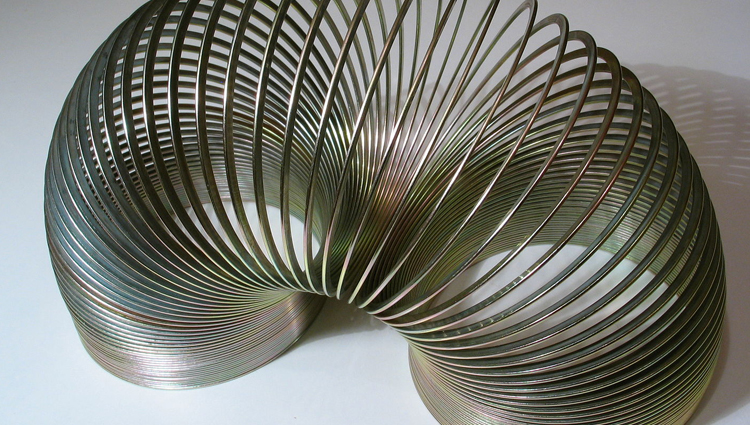Slinky Outtakes

I wasn't able to include all the fun stuff that I learned in my article on Slinky physics, so I thought I would share some "outtakes" that I also thought were interesting.
As a Stanford University undergraduate, Shimon Kolkowitz (now a Harvard Ph.D. student) wrote his online paper on the Slinky as part of a graduate-level elective called "Topics in Advanced Mechanics," taught by Nobel Laureate Robert Laughlin, who shared the Prize in 1998 for a phenomenon known as the fractional quantum Hall effect.
Kolkowitz told me:
"It was an unusual course because instead of having any problems or tests, [Laughlin] had us write two papers about mechanical systems of our choice."
"The way he graded the course was that he read all the papers, but he said if you did the papers, no matter what, you got an A in the course."
"But he was going to put them up on the website [with] a relatively high page rank, and they'd be there for all eternity. So [Laughlin said] other people will find them and you should do a good job, so that if other people google you this will pop up."
Kolkowitz ended the story by saying to me:
"I thought it was funny at the time, but I guess it turns out to be sort of true!"
Here's another story that I didn't have time to mention in the piece:
In his paper, Bill Unruh, the University of British Columbia physics professor I interviewed for the piece, actually considers what he calls an "unphysical Slinky," in which the rings of the falling Slinky would pass through each other like coiled ghosts.
I asked him why he did this, and he explained that the reason is that it was easier to analyze the Slinky through this approach first, without the complications of the coils slamming into each other, which creates the shock wave mentioned in my story. In his thought experiment, the Slinky sort of turns itself inside out.
While this ghostly Slinky doesn't appear to have any actual counterpart in the physical world, Unruh told me his faculty colleagues have imagined building something that would approach it: instead of having a Slinky in which the radius is the same from top to bottom, the idea would be to build a conical slinky in which the higher coils could pass through the lower coils because of the smaller radius and in that kind of a system you can see the coils passing through each other. Though it wouldn't be a perfect realization because the mass of the Slinky would be distributed in a non-uniform fashion, and this would likely affect the speed of the wave traveling through the Slinky.
Anyone planning to do the experiment outlined at the end of the Inside Science piece? Please feel free to share your thoughts--and results!

